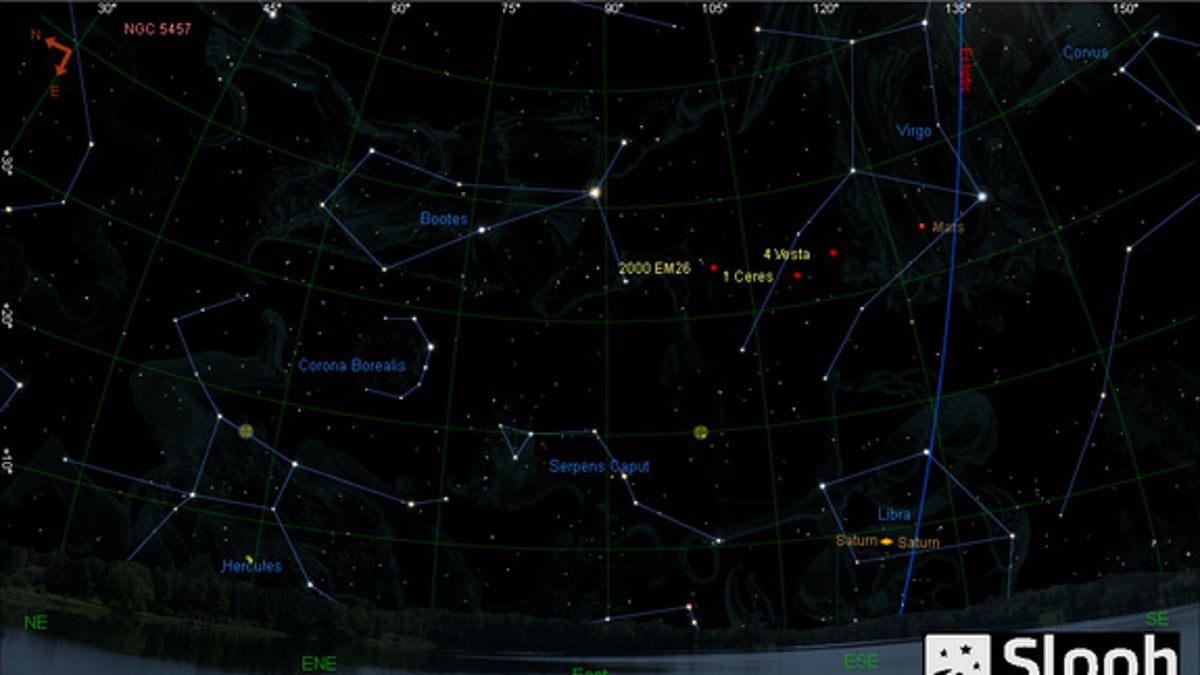
This graphic shows the location of the asteroid 2000 EM26 in the night sky on Feb. 17, 2014 during a live skywatching webcast by the online stargazing venture Slooh. (Slooh)
A gigantic asteroid nearly 900 feet wide will race past planet Earth tonight, a harmless but sobering reminder of the dangers posed by such interplanetary visitors.
On Monday, Feb. 17, at approximately 9:00p.m. EST, the Slooh space telescope will broadcast a live video stream and scientific discussion about the silent visitor, which will be traveling at approximately 27,000 miles per hour when it soars safely past the planet.
The asteroid, called NEA 2000 EM26, will come no closer than 8.8 lunar distances from Earth -- a measure of the distance between us and the moon -- and poses no threat to us.
But awareness of asteroids is our best means of keeping ourselves safe, said Slooh’s technical and research director, Paul Cox.
“We continue to discover these potentially hazardous asteroids -- sometimes only days before they make their close approaches to Earth,” he said in a statement. “We need to find them before they find us!”
- US Navy ready to deploy laser system this summer; rail guns aren’t far behind
- Russian reconnaissance satellite burns up in atmosphere, report says
- Review: ‘Danganronpa: Trigger Happy Havoc’ stars psychopathic teddy bear
- Fundraising website Kickstarter says hackers got customer data
- 17 things that fell from the sky
- 5 Reasons to Care About Asteroids
- In pictures: Giant asteroid 1998 QE2 flies by Earth
Almost exactly one year ago, on Feb. 15, 2013, something unexpectedly tore through the skies over Chelyabinsk, Russia, damaging thousands of houses, breaking innumerable windows, and causing injuries from broken glass. This object, later discovered to be an asteroid, was 65 feet in diameter and exploded 18 miles above Siberia -- releasing the equivalent energy of more than 20 atomic bombs (approximately 460 kilotons of TNT).
[pullquote]
On the same day, asteroid 2012 DA14 -- a 40,000 ton space rock 98 feet in diameter -- missed our planet by a measly 17,200 miles, closer even than satellites orbiting the Earth.
Many believe the residents of Chelyabinsk were extremely lucky to escape this celestial encounter with no loss of life, Slooh representatives said.
To commemorate the event, the Russian government announced that ten gold medals for winners on Feb. 15 at the 2014 Sochi Winter Olympics would be embedded with Chelyabinsk meteor fragments.
Viewers can watch the broadcast free on Slooh.com or by downloading the Slooh iPad app.
Or you can watch it live here, starting at 9:00 p.m. The image stream will be accompanied by discussions led by Slooh host and astronomer, Bob Berman, Slooh technical director, Paul Cox., and special guest, Dr. Mark Boslough, an expert on planetary impacts and global catastrophes.
“On a practical level, a previously-unknown, undiscovered asteroid seems to hit our planet and cause damage or injury once a century or so, as we witnessed on June 20, 1908 and February 15, 2013,” said Berman. “The ongoing threat, and the fact that biosphere-altering events remain a real if small annual possibility, suggests that discovering and tracking all NEOs, as well as setting up contingency plans for deflecting them on short notice should the need arise, would be a wise use of resources."
